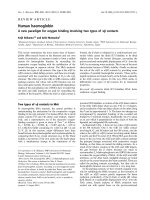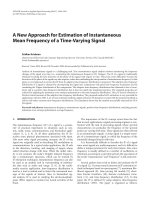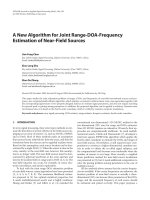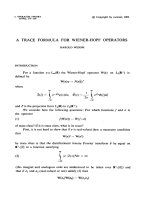Báo cáo toán học: " A NEW CONSTRUCTION FOR CANCELLATIVE FAMILIES OF SETS" doc
Bạn đang xem bản rút gọn của tài liệu. Xem và tải ngay bản đầy đủ của tài liệu tại đây (95.88 KB, 3 trang )
A NEW CONSTRUCTION FOR
CANCELLATIVE FAMILIES OF SETS
James B. Shearer
IBM Research Division
T.J. Watson Research Center
P.O. Box 218
Yorktown Heights, NY 10598
email:
Submitted: March 25, 1996; Accepted: April 20, 1996
Abstract. Following [2], we say a family, H,ofsubsetsofan-element set is can-
cellative if A ∪ B = A∪C implies B = C when A, B, C ∈ H. We show how to construct
cancellative families of sets with c2
.54797n
elements. This improves the previous best
bound c2
.52832n
and falsifies conjectures of Erd¨os and Katona [3] and Bollobas [1].
AMS Subject Classification. 05C65
We will look at families of subsets of a n-set with the property that A∪B = A∪C ⇒
B = C for any A, B, C in the family. Frankl and F¨uredi [2] call such families cancellative.
We ask how large cancellative families can be. We define f(n) to be the size of the largest
possible cancellative family of subsets of a n-set and f(k,n) to be the size of the largest
possible cancellative family of k-subsets of a n-set.
Note the condition A ∪ B = A ∪ C ⇒ B = C isthesameastheconditionBC ⊆
A ⇒ B = C where denotes the symmetric difference.
Let F
1
be a family of subsets of a n
1
-set, S
1
.LetF
2
be a family of subsets of a n
2
-
set, S
2
. WedefinetheproductF
1
× F
2
to be the family of subsets of the (n
1
+ n
2
)-set,
S
1
∪ S
2
, whose members consist of the union of any element of F
1
with any element of
F
2
.
It is easy to see that the product of two cancellative families is also a cancellative
family ((A
1
,A
2
) ∪(B
1
,B
2
)=(A
1
,A
2
) ∪(C
1
,C
2
) ⇒ (A
1
∪ B
1
,A
2
∪ B
2
)=(A
1
∪ C
1
,A
2
∪
C
2
) ⇒ A
1
∪ B
1
= A
1
∪ C
1
and A
2
∪ B
2
= A
2
∪ C
2
⇒ B
1
= C
1
and B
2
= C
2
⇒
(B
1
,B
2
)=(C
1
,C
2
)). Hence f(n
1
+ n
2
) ≥ f (n
1
)f(n
2
). Similarly f(k
1
+ k
2
,n
1
+ n
2
) ≥
f(k
1
,n
1
)f(k
2
,n
2
).
Typeset by A
M
S-T
E
X
1
2
It is easy to show that f(n
1
+n
2
) ≥ f(n
1
)f(n
2
) implies that lim
n→∞
1
n
lg(f(n)) exists
(lg means log base 2). Let this limit be α. Note that α ≥
1
n
lg (f(n)) for any fixed n.
Clearly f(1,n)=n as we may take all the 1-element sets. Let H
n
be the family
of all 1-element sets of a n-set. It had been conjectured that the largest cancellative
families could be built up by taking products of the families H
n
. For example Bollobas
conjectured [1] that
f(k, n)=
k
i=1
[(n + i − 1)/k](1)
which comes from letting n = n
1
+ ···+ n
k
where the n
i
are as nearly equal as possible
and considering the family H
n
1
×···×H
n
k
.Whenk = 2 determining f (2,n)isthesame
as determining how many edges a triangle-free graph can contain. So in this case (1)
follows from Turan’s theorem. Bollobas [1] proved (1) for k = 3. Sidorenko [4] proved
(1) when k =4. FranklandF¨uredi [2] proved (1) for n ≤ 2k. However, we will show
below that (1) is false in general.
Also Erd¨os and Katona conjectured (see [3]) that (for n>1) the families achieving
f(n) could be built up as products of H
3
and H
2
taking as many H
3
’s as possible. So
for example
f(3m)=3
m
. (2)
This would mean α =
lg3
3
= .52832+. However, as we will see this conjecture is false as
well. In fact we show α ≥ .54797+.
We now describe the construction which is the main result of this paper. Fix m ≥ 3.
Chose m − 1integersn
1
, ,n
m−1
from {0, 1, 2} so that n
1
+ ···+ n
m−1
≡ 0 mod 3.
Chose an integer h from {1, ,m}. Clearly these choices can be made in m3
m−2
ways.
We now form a cancellative family of subsets of a 3m-set containing m3
m−2
elements as
follows. Identify subsets of a 3m-set with 0,1 vectors of length 3m in the usual way. Let
the 3m vectors consist of m subvectors of length 3. Let v
0
= (100),v
1
= (010),v
2
= (001)
and w = (111). Form a 3m-vector from our choices above as follows. Let the hth 3-
subvector be w. Let the remaining m − 1 3-subvectors be v
n
1
, ,v
n
m−1
in order. Let
F be the family consisting of all 3m-vectors we can form in this way. Clearly each of the
m3
m−2
choices gives a different vector so F contains m3
m−2
elements. We claim F is
a cancellative family. For let B, C be two different vectors in F and look at BC.We
claim BC contains at least two 3-subvectors with two 1’s. There are two cases. If the
3-subvector w is in different positions in B and C then the 3-subvectors in BC in these
positions contain two 1’s. Alternatively, if the 3-subvector w is in the same position in
B and C then the condition n
1
+···+n
m−1
≡ 0 mod 3 insures that at least two of the n
i
differ between B and C (assuming B and C are distinct) and the 3-subvectors in these
positions of BC contain two 1’s. However, this means BC ⊆ A ∈ F is impossible
(unless B = C) because all elements of F contain only one 3-subvector containing two
or more 1’s.
Hencewehave
f(3m) ≥ m3
m−2
(3)
3
f(m +2, 3m) ≥ m3
m−2
. (4)
Clearly (3) is better than (2) for m>9. We also have α ≥
1
3m
lg(m3
m−2
). This is
maximized for m = 24 giving α ≥ .54797+. So we have counter examples to the Erd¨os
and Katona conjecture.
Furthermore (4) is better than (1) for m ≥ 8. So the Bollobas conjecture fails for
k ≥ 10.
The idea of the above construction which improves on products of H
3
can be applied
to products of other families as well. For example, we can do better than (1) starting
with products of H
k
for any k>3 as well. Or we can start with the families F
constructed above. This will allow a very slight improvement in the lower bound found
for α above.
The best upper bound known for α, α < lg(3/2) = .58496+, is due to Frankl and
F¨uredi [2].
The author thanks Don Coppersmith for bringing this problem to his attention.
References
[1] B. Bollob´as, Three-Graphs without two triples whose symmetric difference is contained in a third,
Discrete Mathematics 8 (1974), 21–24.
[2] P. Frankl and Z. F¨uredi, Union-free Hypergraphs and Probability Theory, European Journal of
Combinatorics 5 (1984), 127–131.
[3] G.O.H. Katona, Extremal Problems for Hypergraphs, Combinatorics, Mathematical Centre Tracts
part 2 56 (1974), 13–42.
[4] A.F. Sidorenko, The Maximal Number of Edges in a Homogeneous Hypergraph containing no pro-
hibited subgraphs,MathematicalNotes41 (1987), 247-259 (translation from Mathematicheskie Za-
metki 41 (1987), 433-455).









